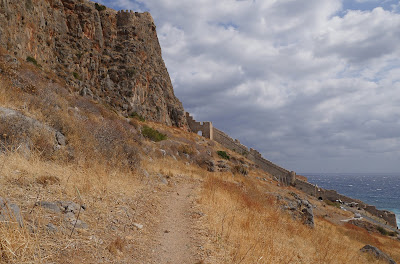Monemvasia
Monemvasia is a vast rock a kilometre long long and about 300 m high. It is connected to the mainland by a narrow 200m causeway - its name means "single entrance". The town is at the furthest (right) end away from the mainland and high above it on top of the rock was a castle long famous for its impregnability: it only fell to invaders who could wait around long enough to starve out its defenders.
The town and castle were founded in 580 AD by Greeks seeking safety from invaders. By the 10th century it was an important castle, administrative centre and seaport (for example as a source of Malvasia wine [Malmsey] for England). The whole Byzantine period in the Peloponnese from the fall of Rome to the fall of Constantinople to the Turks (1453) was marked by frequent invasions (actual or attempted) by a great variety of forces: Franks, Normans, Arabs, Slavs, Bulgarians, mercenaries such as the Catalan Company, and others). After 1453 it was briefly owned by the Papacy and then the Venetians, before becoming a Turkish possession from 1502 until 1821 when it became part of Greece during the War of Independence.
We could see that cars were parked all along the road on the right side of the island and we decided to leave our hire car on the mainland and walk across the causeway along the road. Once we got across, dodging the spray from a wild sea, we soon spotted a sign for a footpath parallel with the road and part-way up the hillside. This was much more pleasant.
The great bonus to be gained from this route was that we approached the town midway between the gate to the lower town on the right and that leading to the upper town on the left.
We decided to head upwards and once through the gate, we had our first views of the lower town from above ...
... quickly followed by looking up to the substantial defenses of the upper town.
We climb up and entered the upper town via a narrow entrance tunnel.
The buildings of the upper town are in pretty poor shape, although there was a curiously atmospheric nave of a church which had been somewhat restored. Further up a very lovely, substantially restored 12th century church.
Inside there was some nice terracotta work and some fragmentary frescoes.
We decided we might as well compete the job by heading across the high plateau to the ruins of the castle at the far (landward) end.
There was really not a lot to see when we got there, but the view down over the causeway to the village of Gefyra was very satisfying.
We retraced our steps and descended through the upper town to the more gentrified lower one. The main square was very picturesque.
We enjoyed a drink in a bar and then got slightly lost in the maze of small streets, eventually emerging though the lower gate and returning across the causeway.
Conditions: hot and sunny (again).
Distance: maybe three miles, but lots of climbing.
Rating: five stars. A wonderful place and mercifully not crowded.













No comments:
Post a Comment